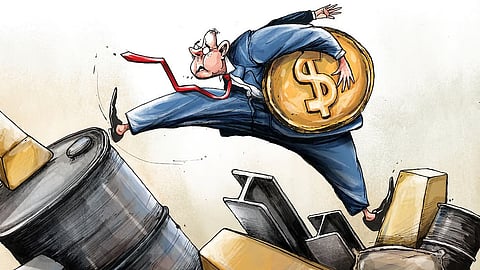

Uncertainty, fear of the debasement of purchasing power through inflation, and the comfort of real things are driving investors to invest in commodities.
Gold has been one beneficiary alongside oil and gas, as well as transition-critical minerals such as copper, nickel, cobalt, lithium and rare earths. The focus is scarcity-driven due to stagnant investment in new production.
But investors, both direct and those seeking exposure through funds, face challenges in investing in these assets.
There are two main ways of investing in commodities—shares in resource firms or in the minerals themselves.
Both present unique complexities. Investment in shares of resource companies is complicated by multiple factors.
Pure exposure to the desired commodity is difficult to obtain.
Many miners are diversified. BHP, the world's largest mining company by market capitalisation, is a producer of iron ore, copper and metallurgical coal.
Storied Anglo-American has operations covering diamonds, copper, iron ore, coal, nickel, manganese and platinum group metals.
Asset portfolios are constantly changing through mergers, acquisitions, joint ventures and divestments. In 2022, BHP shifted its oil and gas assets into a joint venture to reduce involvement in carbon-based fuels. After rejecting a takeover offer from BHP, Anglo-American proposed a complex restructure to focus on copper and iron ore.
Oil and gas firms have vacillated about renewable energy investments. Even where a ‘pure play’ exists, there are other issues. Estimates of reserves may be incorrect.
In 1997, Bre-X Minerals, a major Canadian miner, collapsed with large losses to investors after fraudulently contaminating core samples with gold derived from other sources. An old definition of a mine is 'a hole in the ground with a liar standing next to it’.
The exposure may be diluted by currency effects as resource companies operate in different jurisdictions.
Many firms hedge their commodity price exposure to ensure revenues are sufficient to ensure satisfactory returns. For an investor seeking exposure to price appreciation of the commodity, this alters the investment dynamics.
A hedged producer does not necessarily benefit from higher prices. Hedging introduces new risks.
A number of companies have faced financial distress as a result of increased margin requirements on hedges. In 1999, a sharp rise in gold prices drove Ghana’s Ashanti Gold, which had locked in the metal’s price, to near bankruptcy.
There are other problems too. Production difficulties, including weather factors, may dilute commodity price effects.
Lower output from one producer may adversely affect shareholders. The risk of accidents and legal liabilities—such as the Brazilian tailing dam failure which affected BHP and Vale, or BP’s Mexican Gulf oil spill—is ever present.
Increasingly, political risk—sanctions, expropriations, trade restrictions—and changing local regulations are also rising concerns. Corporate financial engineering—the amount of leverage, refinancing risk, borrowing costs—affects the share price performance of individual firms.
The US shale oil industry is heavily dependent on the cost and supply of credit. Exposure to the stock may not translate into exposure to the commodity sought.
Direct investment in the commodity itself is equally fraught. Commodities are not traded in the same way as financial assets making it difficult to obtain exposure.
There is frequently no spot market with most transactions undertaken under long term contracts. Physical ownership is difficult due to issues like storage, transportation, insurance, logistics and risk of fraud. The risk of confiscation is real.
In 1933, the US forbade hoarding of gold, requiring all persons to sell their holdings to the Federal Reserve at a fixed price. In practice, investors use funds or other collective investment vehicles which concentrate on liquid instruments to cover fund redemptions.
Most track indicators such as the Goldman Sachs Commodity Index which are heavily weighted to tradeable commodities such oil and gas and currency-like precious metals like gold and silver.
It is difficult to get exposure to rare earths, titanium, nickel or lithium, which generally require fund investors to accept exposure to illiquid small companies.
Most commodity funds’ disclosure documents include special warnings on this point. Funds often use commodity derivatives to gain exposure to commodities because of difficulties in trading the underlying.
The fund is then exposed to the risk of failures of the counterparty, typically banks, traders or hedge funds.
As derivatives transactions require collateral, the funds are exposed to unexpected margin calls. Increasing financialisation of the commodity supply chain means that traders, rather than producers and users, now shape prices.
Derivatives now dominate over the fundamentals of supply and demand. Commodity traders, who operate across the entire supply chain, can alter prices through derivative trading and control over operations.
Pricing peculiarities such as backwardation—when forward prices trade below spot prices—mean that derivatives do not always track the underlying commodity price to which the investor seeks exposure. At best, commodity funds provide generalised investment in the asset and an inaccurate hedge against inflation.
Investors end up exposed to the index used and a variety of extraneous factors because of their construction and fund operation. In recent years, commodity indices have under or over-performed because of their heavy energy weighting providing inaccurate exposure to sectors such as transition critical materials and agricultural prices.
These difficulties have led to a search for alternatives. Some have experimented with proxies.
This entails investing in firms that might gain or lose from price movements such as trading companies or commodity users, such as airlines or electronics firms.
Others have used currencies—the Australian dollar, Brazilian real and pre-sanction Russian rouble—that respond to commodity price fluctuations. At best, investors end up with investments whose actual returns may not accurately track commodity price moves.
They may be right, at least in their theoretical investment logic, but are practically unable to capture it in their results. It may leave investors sympathising with poet Emily Dickinson: "I want to move to theory. Everything works in theory."
Satyajit Das | Former banker and author of The Age of Stagnation
(Views are personal)
